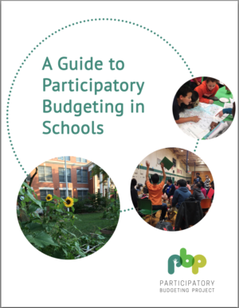 The 57-page guide, A Guide to Participatory Budgeting in Schools, was a project of the Participatory Budgeting Project (PBP) and published in 2016. The guide’s curriculum design was created by Valeria Mogilevich, with project support by Melissa Appleton and Maria Hadden of PBP. This thorough guide gives details for implementing a participatory budgeting process within schools. Participatory budgeting is a process where people decide where to spend a portion of a budget by engaging their community- or in this case- their school, and vote on projects to make final decisions. The guide is rich with process details, helpful hints, plan layouts, and useable worksheets. There are 18 lesson plans and 6 worksheets provided in this guide to get a PB process launched in schools over the course of a semester or school year. Sections include: – Planning – Idea Collection – Proposal Development – Voting – Implementation and Beyond – Worksheets Below is an excerpt from the guide, you can find it in full at the bottom of this page and directly from PBP’s site here. From the guide… So, you’re interested in doing Participatory Budgeting in your school. Great! This guide will help you plan it. Participatory Budgeting is a democratic process in which community members decide how to spend a part of a public budget. In this case, the community members are students and the budget is the school budget. Students collect ideas about the school’s needs, develop project proposals, and vote on projects to fund. We know Participatory Budgeting is a mouthful, so we’ll call it PB from now on. The process was first developed in the city of Porto Alegre, Brazil in 1989. In Porto Alegre, as many as 50,000 people have participated each year to decide as much as 20% of the city budget. Since 1989, PB has spread to over 1,500 cities in Latin America, North America, Asia, Africa, and Europe. In the US and Canada, PB has been used in Toronto, Montreal, Guelph, Chicago, New York City, and Vallejo (California). Most of these PB processes are at the city level, for the municipal budget. PB has also been used, however, for counties, states, housing authorities, schools and school systems, universities, coalitions, and other public agencies. We heard from a lot of people (through a PB process, actually) that they wanted help bringing PB to their schools. We wrote this for educators and principals looking to incorporate PB into their classroom during the school day. Why PB? Participatory Budgeting is great to bring into your classroom because:
By participating in a PB process, students will:
How it works This curriculum is set up to take place:
The idea is to focus on Participatory Budgeting one day of the week and leave the rest of your week to your regular content. We know that might not sound exactly like you. That’s OK! Everyone’s schedule and needs are different, so you can compress it by meeting more times a week. What you’re seeing here is the most efficient way to get through a Participatory Budgeting process. You can also spend more time on specific phases of the process and stretch it out into a whole year. “Once you give young people the opportunity to help shape their community, they are incredibly willing and able to step up to that challenge. And students’ expertise is so needed as we work to improve education across the country. Youth-driven participatory budgeting in schools is an excellent tool to harness that expertise to create positive, constructive change.” -Mia Salamone, Democracy in Action Coordinator, Mikva Challenge, Chicago, IL “In our school we are low income and there’s negative stereotypes about our school and who we are, yet [our principal] is trusting us to make decisions about our education and never doubted parents and students like me would make the best decisions, and that is being shown by the project proposals we all have the ability to vote on.” – Stephania Perez, Sophomore, Overfelt High School, San Jose, CA To learn more about bringing participatory budgeting to schools, check out the guide in full below or on PBP’s site here. About the Participatory Budgeting Project
The Participatory Budgeting Project (PBP) is a non-profit organization that helps communities decide how to spend public money, primarily in the US and Canada. Their mission is to empower community members to make informed, democratic, and fair decisions about public spending and revenue. Follow on Twitter @PBProject Resource Link: Guide to Participatory Budgeting in Schools
0 Comments
Your comment will be posted after it is approved.
Leave a Reply. |
Categories
All
|
Follow Us
ABOUT NCDD
NCDD is a community and coalition of individuals and organizations who bring people together to discuss, decide and collaborate on today's toughest issues.
© The National Coalition For Dialogue And Deliberation, Inc. All rights reserved.
© The National Coalition For Dialogue And Deliberation, Inc. All rights reserved.


 RSS Feed
RSS Feed